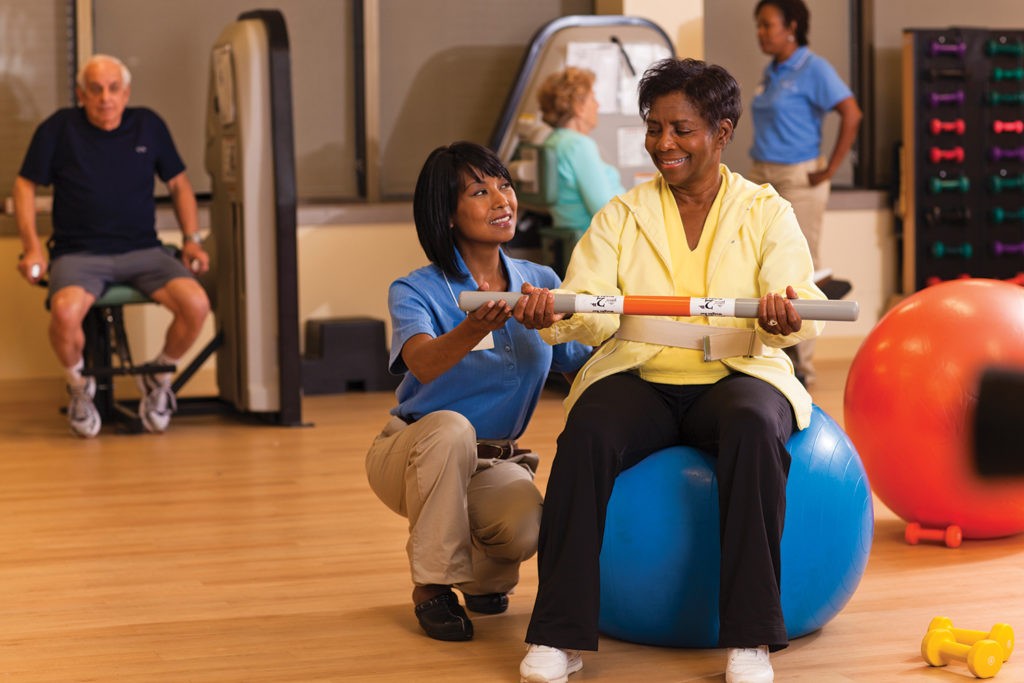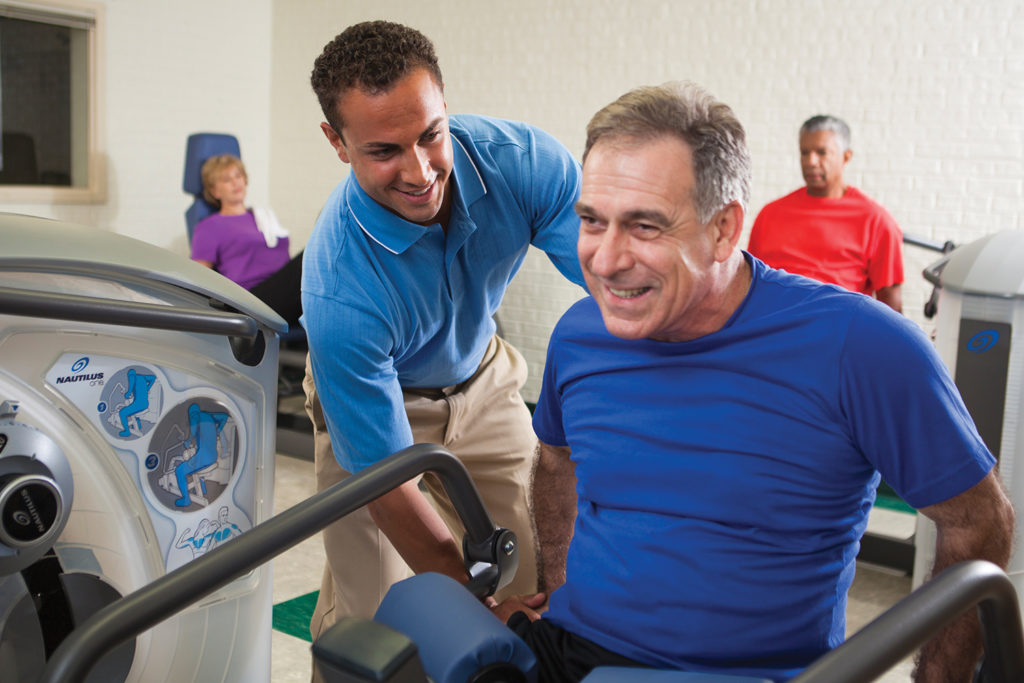Rehabilitation Services

Helping Patients Return to Doing the Things They Love to Do
Getting patients to the highest level of functional independence is the primary goal of rehabilitation.
It’s easy to take our daily activities for granted. We walk the dog, mow the lawn, vacuum the house or play some basketball. We most often don’t give a second thought about having to bend, move, lift, throw or push without limitations. But life can change in a flash. An unexpected injury or illness can take away those abilities, and what used to be part of our everyday activities suddenly becomes a series of monumental tasks.

Recovering from an accident, illness, injury or disease can be scary. On the flip side, so is remaining exactly the same. Rehabilitative or rehabilitation services are an arm of health care services designed to help patients keep, restore or improve skills and functioning for daily living purposes that have been lost or impaired due to illness, injury or disability. Rehabilitation includes assisting patients to compensate for deficits that cannot be reversed by medical means. In other words, these services help people return to a normal or near-normal way of life. Services may include physical therapy, occupational therapy, speech and language therapy, cognitive therapy and mental health rehabilitation services. These services may be offered in a variety of in-patient and/or out-patient settings.
 “An acute rehabilitation hospital setting offers a full continuum of rehabilitation programs and services,” indicated Dr. Cielo Navato-Dehning, Medical Director of MidAmerica Rehabilitation Hospital. “Rehabilitation in the appropriate setting provides for maximum potential for recovery. MidAmerica Rehabilitation Hospital is very people based. All of us on staff are passionate about getting our patients to a higher level of functionality so they can return to their lives.”
“An acute rehabilitation hospital setting offers a full continuum of rehabilitation programs and services,” indicated Dr. Cielo Navato-Dehning, Medical Director of MidAmerica Rehabilitation Hospital. “Rehabilitation in the appropriate setting provides for maximum potential for recovery. MidAmerica Rehabilitation Hospital is very people based. All of us on staff are passionate about getting our patients to a higher level of functionality so they can return to their lives.”
There are myriad reasons why someone might need care through rehabilitation. These include injuries and trauma from burns, loss of limbs, or amputation, fractures, traumatic brain injury, spinal cord injury, loss of sight or hearing, or fractures to the long bones in the limbs or of the hip, spine or skull. Certain diseases that can cause loss of mobility function include spina bifida, cerebral palsy, muscular dystrophy, arthritis, knee or hip replacement, stroke, Parkinson’s disease and multiple sclerosis. Individuals who have undergone surgery or prolonged treatment for disease or illness can benefit from rehabilitative care, and this includes those suffering from chronic pain, severe infection, diabetes, certain cancers, peripheral artery disease and cardiac arrest. In addition to physical limitation, certain intellectual and developmental disabilities may benefit from rehabilitation medicine through occupation or physical therapy, for example.
Additionally, many patients who have any of the disorders mentioned also deal with the secondary effects of those issues that can have a negative impact on the patients’ health, quality of life and independence. Rehabilitation may include treatments for secondary symptoms such as ulcers, bed sore, sepsis, balance or vision problems, bladder and bowel issues, breathing difficulties, muscle atrophy, obesity, circulation issues, and certain emotional or cognitive difficulties.
You may never expect to get sick or injured but you never know what challenges life might throw your way. While we may worry about sustaining a heart attack or being diagnosed with cancer, many of us probably don’t see ourselves confined to a wheelchair for life. However, there are 50 million people with disabilities in the United States. The goal of rehabilitation is to help patients learn how to care for a body that functions at a “new normal,” differently than it did before, while simultaneously working to avoid those secondary complications.

The rehabilitation process is a different experience for everyone, but care will typically involve inpatient rehabilitation that follows an acute-care hospital stay for serious injuries and medical conditions such as a stroke, brain injury or multiple traumas. During inpatient rehabilitation, regaining function and independence is the ultimate goal, and this is achieved via various forms of therapy – physical, occupational, speech or recreational on a daily basis. It is essential to have a multidisciplinary team of doctors, therapists and nurses to help develop and oversee a treatment plan to meet each patient’s individual goals.
“Acute rehabilitation hospitals like MidAmerica Rehabilitation Hospital offer a higher level of care and expertise,” explained Dr. Navato-Dehning. “We are a passionate team, highly educated, bringing the newest treatments and innovative technology that includes a multidisciplinary approach. Where you go for rehabilitation does make a difference in your outcome.”
Once discharged from inpatient care, outpatient rehabilitation is recommended to help patients maintain and improve function. Patients with less serious conditions may be referred straight to an outpatient facility for treatment. Joining a medical model fitness center fitness class or support group may be recommended on an on-going basis to maintain function.
During rehabilitation, it is important to remember sometimes just taking the smallest step in the right direction can make a difference.
For more information on the MidAmerica Rehabilition Hospital, call 913.491.2400 or visit midamericarehabhospital.com
Sources: thefreedictionary.com, cancer.gov,nichd.nih.gov, healthcare.gov, medlineplus.gov, merckmanuals.com






